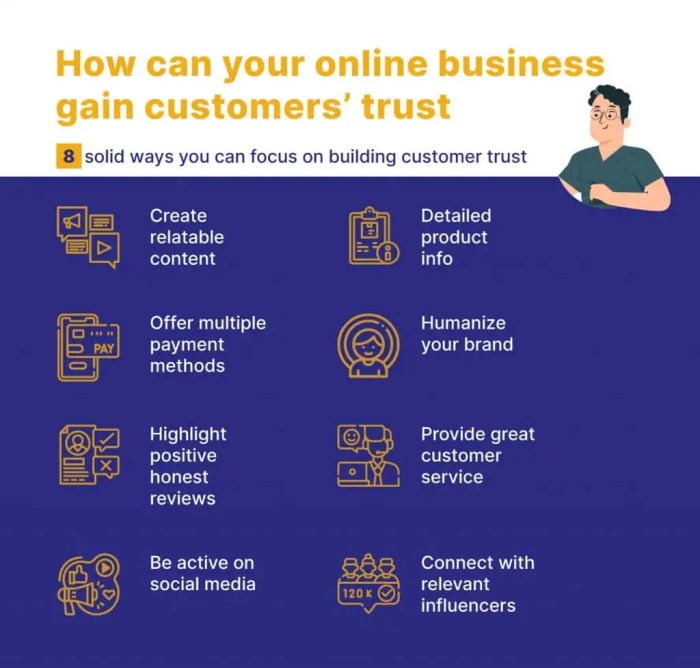Using Customer Reviews to Build Trust sets the stage for businesses to connect with their audience on a deeper level, showing the power of feedback and transparency in shaping consumer trust.
Diving into the impact of customer reviews and strategies to leverage them effectively, this guide offers insights on enhancing credibility and reputation in the digital age.
Importance of Customer Reviews

Customer reviews play a crucial role in building trust for a business. They provide social proof and allow potential customers to gain insights into the experiences of others before making a purchase decision.
Impact on Business Reputation
Customer reviews can significantly impact a business’s reputation. Positive reviews can help establish credibility and trustworthiness, while negative reviews can tarnish a company’s image. For example, a restaurant with glowing reviews about its food and service is likely to attract more customers, while a hotel with multiple complaints may struggle to attract guests.
Influencing Purchasing Decisions
Customer reviews have a direct influence on purchasing decisions. Many consumers rely on reviews to determine the quality and reliability of a product or service. According to a survey by BrightLocal, 91% of consumers read online reviews before making a purchase decision. Positive reviews can lead to increased sales, while negative reviews can deter potential customers from buying.
Strategies for Leveraging Customer Reviews
When it comes to leveraging customer reviews, there are several key strategies that businesses can implement to make the most out of this valuable feedback.
Encouraging Customers to Leave Reviews
- Offer incentives such as discounts or freebies for customers who leave reviews.
- Make it easy for customers to leave reviews by providing clear instructions and multiple platforms to choose from.
- Send follow-up emails or messages requesting feedback after a purchase or interaction with the business.
Benefits of Showcasing Customer Reviews on a Company Website
- Build trust and credibility with potential customers by showcasing real feedback from past clients.
- Improve by adding fresh content and s to your website through customer reviews.
- Gain valuable insights into customer preferences, pain points, and areas for improvement.
Responding to Reviews Effectively
- Respond promptly to both positive and negative reviews to show that you value customer feedback.
- Thank customers for positive reviews and address any concerns or issues raised in negative reviews.
- Take the conversation offline if necessary to resolve any issues privately and show that you are committed to customer satisfaction.
Building Trust through Transparency: Using Customer Reviews To Build Trust

Transparency in customer reviews refers to the openness and honesty displayed by companies when sharing feedback from customers. This transparency plays a crucial role in building trust with consumers as it shows that the company values the opinions of its customers and is willing to address both positive and negative feedback openly.
Examples of Companies Embracing Transparency
- Amazon: The e-commerce giant prominently displays customer reviews on product pages, allowing shoppers to make informed decisions based on real feedback.
- Zappos: The online shoe retailer encourages customers to leave detailed reviews, including sizing information and product quality, to help others make confident purchases.
- Airbnb: The accommodation booking platform shows transparent reviews from both guests and hosts, promoting trust and accountability within the community.
Impact of Authenticity in Customer Reviews, Using Customer Reviews to Build Trust
Customer reviews that are authentic and honest have a significant impact on consumer trust. When potential customers see genuine feedback from past buyers, they are more likely to trust the company and feel confident in their purchasing decisions. Authentic reviews also help in building credibility and loyalty among existing customers, leading to repeat business and positive word-of-mouth recommendations.
Utilizing Customer Feedback for Improvement
Customer feedback is a valuable resource for businesses looking to enhance their products or services. By listening to what customers have to say, businesses can pinpoint areas that need improvement and make necessary changes to better meet customer needs and expectations.
Identifying Areas for Improvement
When analyzing customer reviews, businesses can look for recurring themes or common issues that customers are experiencing. Whether it’s slow shipping times, poor customer service, or product quality concerns, identifying these pain points can help businesses prioritize areas for improvement.
Importance of Acting on Customer Feedback
Acting on customer feedback is crucial for building trust and loyalty. When customers see that their feedback is being taken seriously and that changes are being made based on their suggestions, they are more likely to continue doing business with the company. This proactive approach demonstrates a commitment to customer satisfaction and can help foster long-term relationships.
Strategies for Implementing Changes
- Set up a system for collecting and analyzing customer feedback regularly.
- Prioritize feedback based on the impact it can have on the overall customer experience.
- Communicate changes to customers to show that their feedback is being heard and acted upon.
- Monitor the results of changes made based on customer feedback to ensure they are effective.